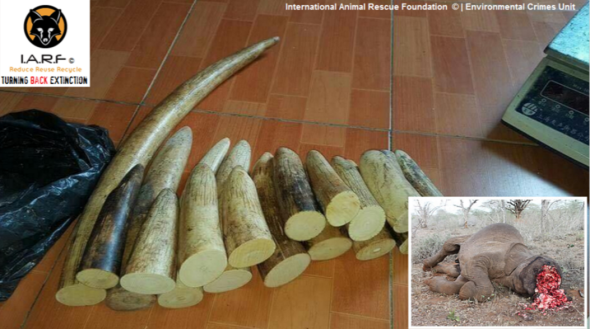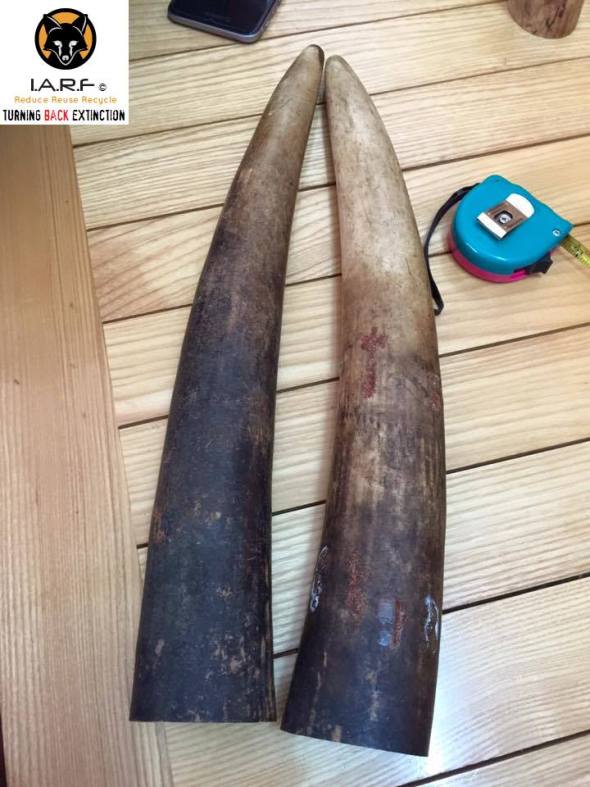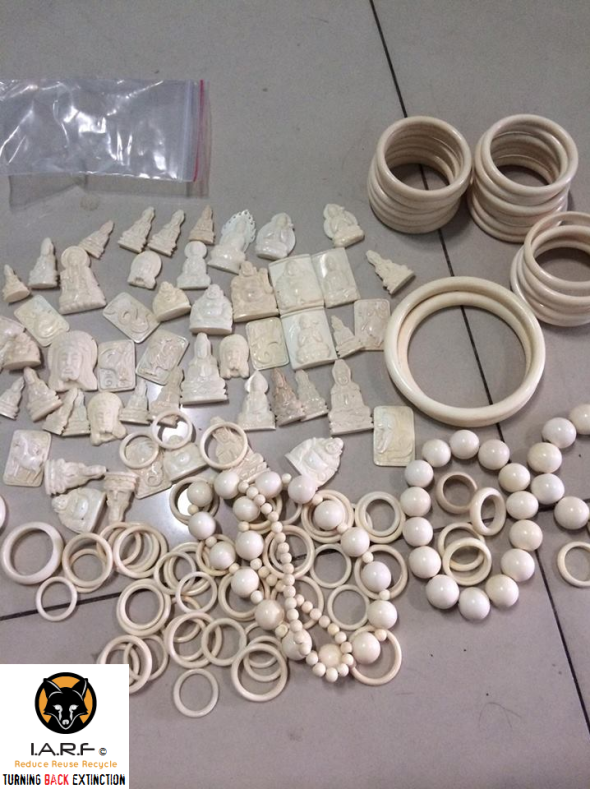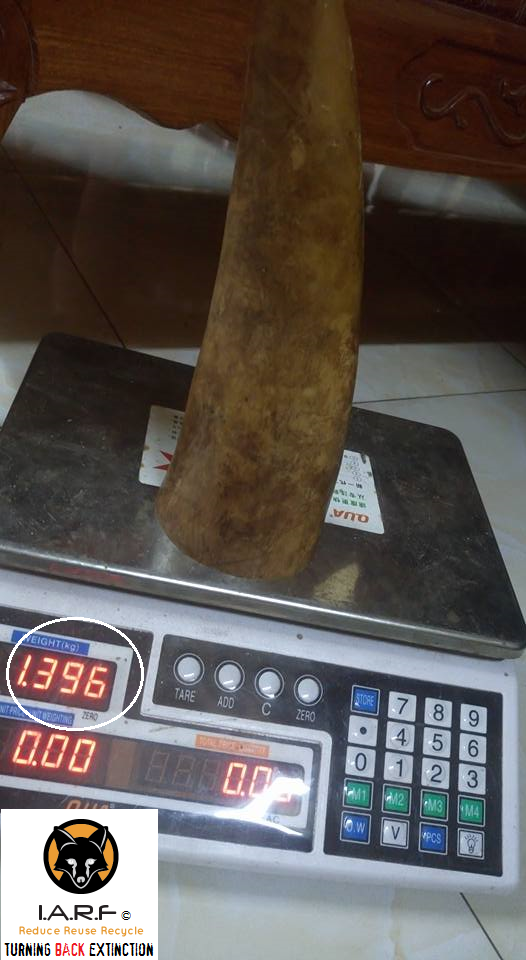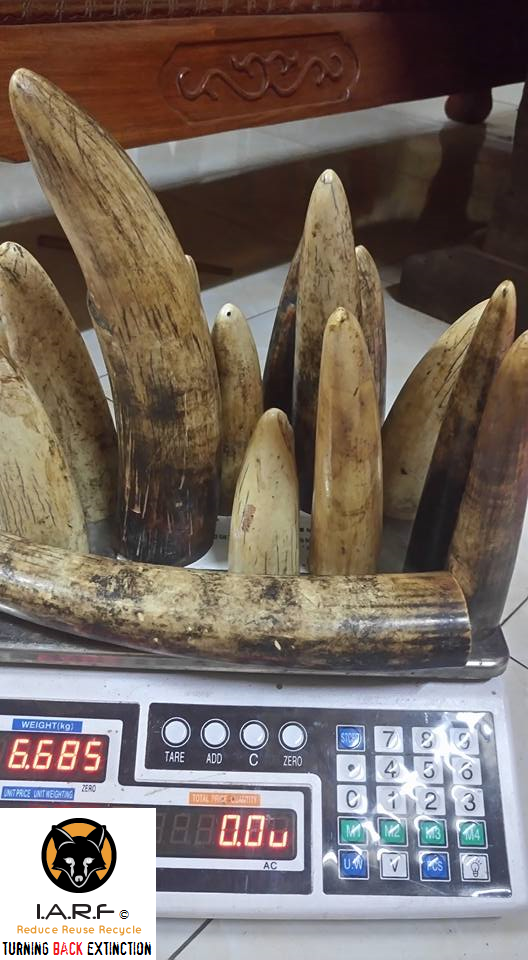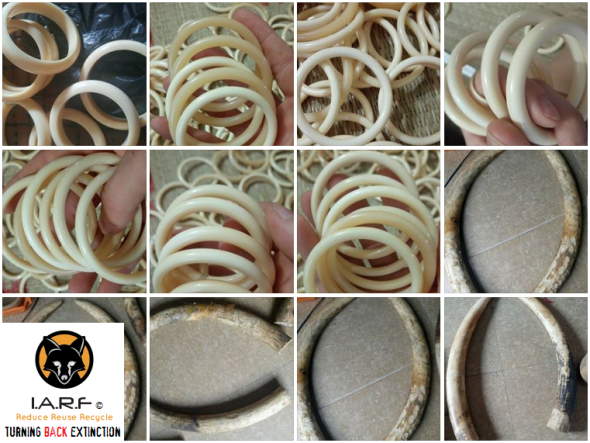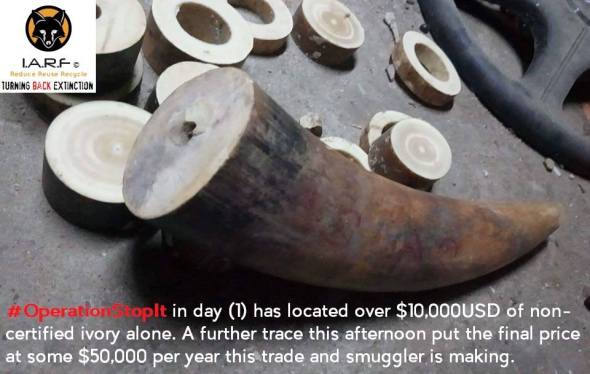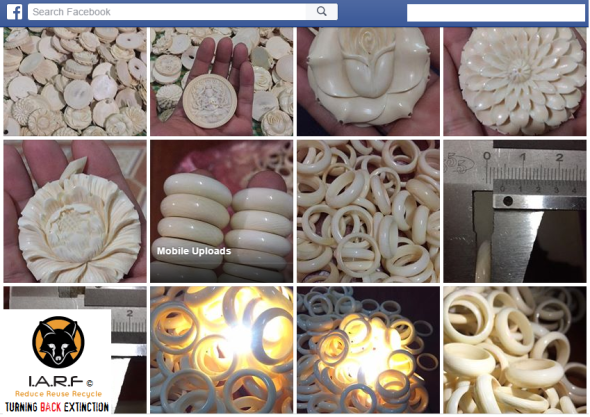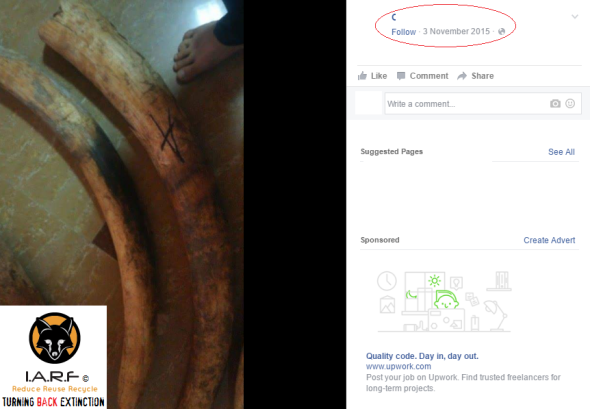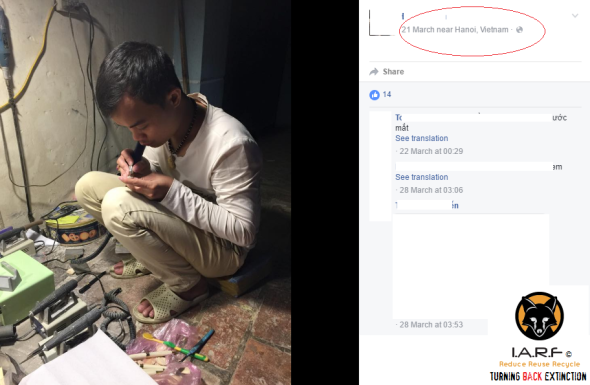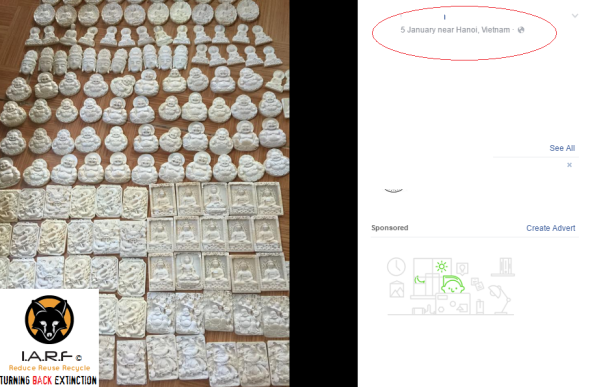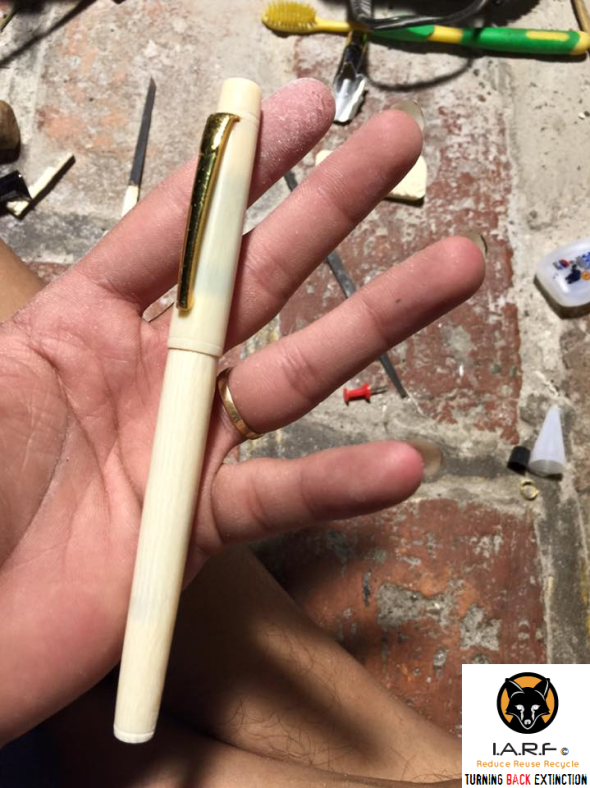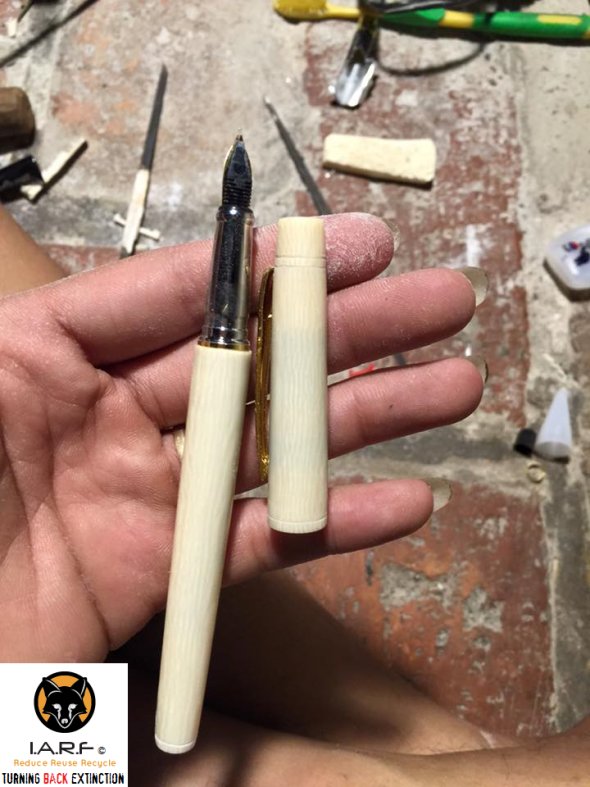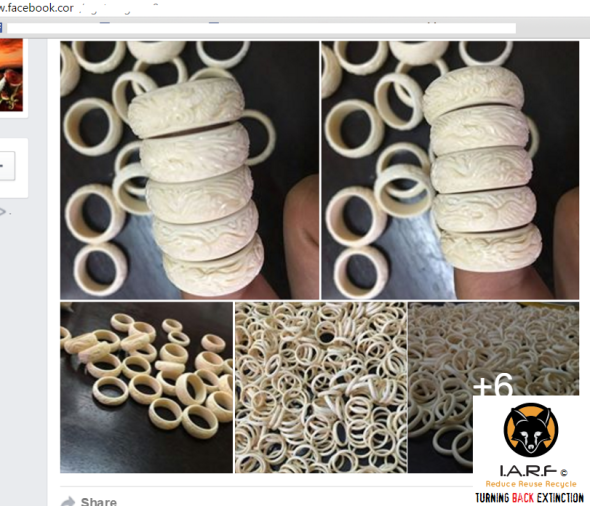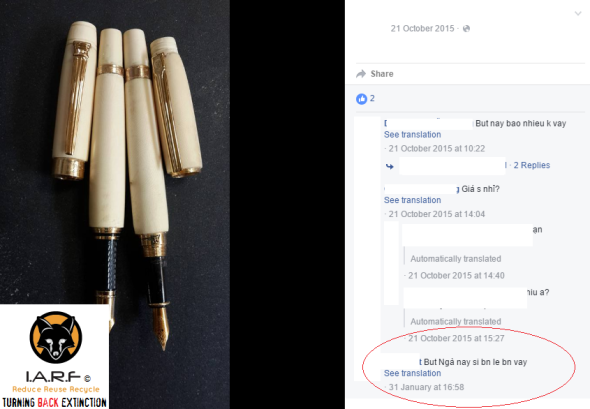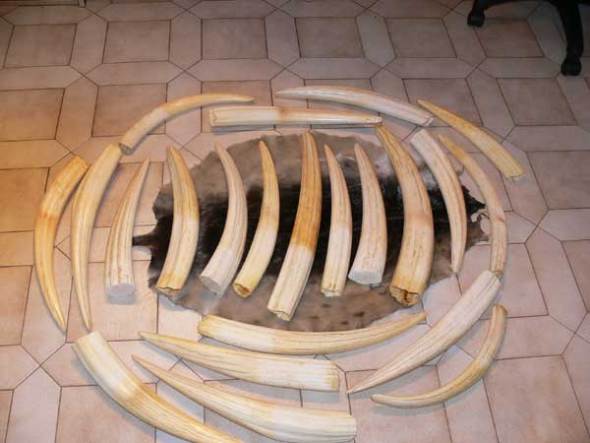WHY ARE WE STILL HUNTING RHINOS FOR | WHEN NO AMOUNT OF FUNDING HAS REDUCED POACHING?
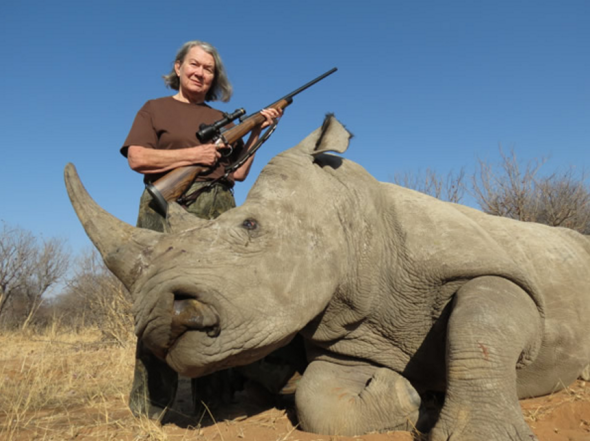
WHY ARE WE STILL HUNTING RHINO?
Why are foreign and native Africans still trophy hunting Rhinoceros for, when no amount of funding generated from these hunts has actively decreased poaching? Image credit: (Mrs Janice Hull, Limcroma South Africa).
Over five years ago I and a group of dangerous game hunters (DGH’s) were involved within a heated debate relating to the money allegedly generated from rhino hunting. The question I asked (and continue to ask) was: “Why are we still hunting rhino for when the money generated from these hunts doesn’t appear to be having any affect whatsoever on decreasing rhino poaching or increasing conservation efforts and security for African rhinos”? (Image above: Hunter - American Janice Hull).
The answer[s] I received were mixed opinions, abuse, and lies. I aimed this question at a number of professional hunters - (PH’s) working in South Africa, and Namibia most of which were American. While the vast majority of dangerous game hunters stated money raised from hunts was directed back into rhino conservation, I’m still after five years questioning where this money is actually going because rhino poaching is not decreasing whatsoever?
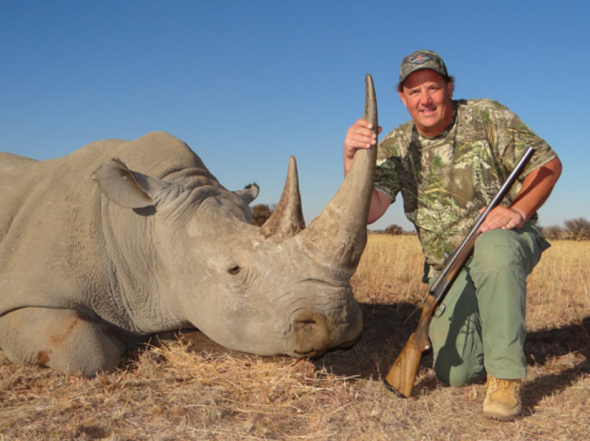
Image Credit: Trophy hunter Mr Loddie Naymola
Since 2008 poachers have slaughtered a staggering 5,940 Rhinoceros - most of which have been poached within South Africa’s flagship park identified as the Kruger National Park. From the year of 2007 rhino poaching figures began increasing rapidly. A total of 13 rhino were bludgeoned to death in 2007. Meanwhile in 2009 South Africa lost a further 122 rhinos (due to poaching).
However come 2011 we really began to see poaching figures rise, come the end of December 2011 a whopping 448 rhinos had been slaughtered by poachers to fuel the Asian demand for pseudo rhino horn medicine. Come 2013 figures shot through the roof resulting in some 1,003 rhinos poached stated the Department of Environmental Affairs come 2013 December end. Then the largest stats were reported back in 2014 of which South Africa lost some 1,215 Rhinoceros to poachers. Yet ‘hunting revenue is preserving our ionic species’?.
Unfortunately at some point from 2014-2016 the Department of Environmental Affairs Minster Honorable Edna Molewa placed a complete ban on the public reporting of any rhino poaching figures, there was no reason as to why this ban was implemented, of which to date still remains in place. Coincidentally (2015’s poaching statistics) had decreased somewhat - of which come December 2015 some 1,175 rhinos had ‘allegedly been poached’. Isn’t that coincidental, a blanket ban on poaching figures is ordered, then come the next year a decrease is seen!.
SOURCE: POACHING STATISTICS.
The SOUTH AFRICAN DEFENCE WEB stated back in January 2016 that a ‘lack of rhino poaching information was negatively affecting anti poaching’. However despite the governmental blackout on rhino poaching incidents numerous organisations such as ‘Stop Rhino Poaching and ‘Outraged South African Citizens against Poaching’ had reported via media, press and anti poaching reports a small rhino poaching decline.
However both of these organisations didn’t obtain their reports from the government, or did they?. So last years poaching stats could indeed be higher than what has been stated in the public domain. Furthermore both Facebook/Online groups/NGO’s share there statistics openly. So in all honesty there is no evidence whatsoever to prove a poaching decline from 2015 has occurred. Moreover and as explained - I myself find it awfully suspicious that since the 2015 poaching report blackout by the South African government - poaching stats just coincidentally decrease like that?.
Elise Daffue whom ‘allegedly runs some form of rhino intelligence group’ (on Facebook - identified as Stop Rhino Poaching), and not in the actual field, stated: “The drop in kills is testimony to the huge effort being made on the enforcement side. Environment Asset Protection strategies have been formulated and implemented over the past three years, guiding the strategic and operational plans nationally – from the ranger in the bush who detects the spoor to the prosecutor who fights that bail is denied. Keeping the numbers down depends entirely on good field work and reserve security, good investigations and good convictions”
While Elise Daffue has stated there was a drop in rhino poaching due to a “huge effort being made on the enforcement side” there remains no evidence whatsoever proving there has been a decline in rhino poaching from 2014-2015. Moreover if there is evidence where has this data come from?. Furthermore whenever we see hunters and ‘animal lovers mingling together’, regardless of what you state your organisation is and does - alarm bells begin ringing, especially coming close to the next CoP summit.
The Founder of Stop Rhino Poaching is friends with a hunter identified as Gustav Collins who runs the Mattaniah Game Reserve Furthermore Elise Daffue is also associated with the individual known as Simon James Naylor who is the Conservation Manager for Phinda Private Game Reserve of which has connections to various hunting organisations and the (WWF) that supports sustainable hunting of Rhinoceros within South Africa and Namibia. Finally (among many others) we have Mr Mark Lautenbach who works as a Specialist Freelance Guide at Ukuthula Lodge. Elise Daffue founder of Stop Rhino Poaching is also friends with a Department of Environmental Affairs worker, and numerous other governmental bodies, police and hunters.
While the above details may not seem overly important, when we’re trying to locate data on hunting statistics, money generated from these activities and more, suspicions are raised when we locate so called professional organisations that are connected to numerous hunting organisations; and institutions such as ‘petting farms’ I.e Ukutala Lodge that has connections with the canned hunting industry and, has featured in a (Blood Lion documentary).
So as one can see it all becomes rather confusing when all we want is upfront and honest answers, however when we ask questions and later find out there are numerous connections to the hunting and possibly ‘pseudo hunting trade’ will we even obtain a serious, straightforward and honest answer? When we’re lied to by hunters, how can we possibly trust Non-Governmental Organisations that are aligned to the very people whom are lying, and are hunting our rhinos while pretending to be so called conservationists? Moreover we (the organisation) do not believe there has been any decline whatsoever relating to rhino poaching. We do though believe that this so called ‘decline may be playing a role in this months CoP17 Summit’ relating to rhino horn legislation.
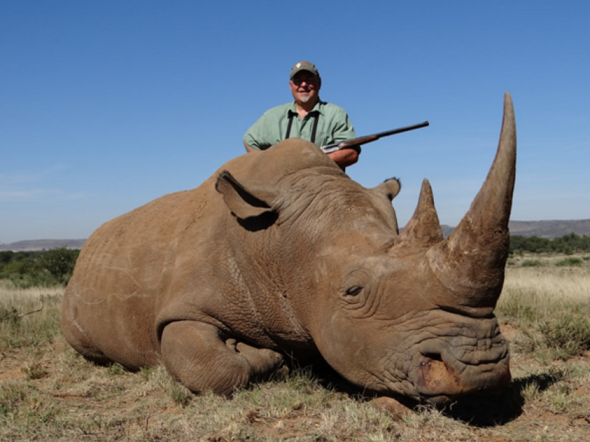
Image Credit: European trophy hunter, Mr Dennis Schemmel
Back in July 2016 it was reported that Rhinoceros poaching was finally without a doubt at ‘tipping point’. South Africa has seen the largest poaching rates recorded at some 72% from 2011-2015. Namibia recorded a loss of 10.8% from 2012-2015. Zimbabwe recorded a loss of 3.1% from 2012-2015. Kenya has recorded a loss of 4.4% from 2012-2015. Finally ‘other African range states mainly in Central Africa’ recorded a loss of 2.5% from 2012-2015.
While its been reported that some 25,000 Rhinoceros remain on the African continent - a depressing near six thousand have been poached all over the continent from 2012-2015. Yet hunting revenue from one of Africa’s most expensive game animals is allegedly reducing poaching? How is this possible, when we’ve lost so many rhinos, and reports from the Global Initiative have confirmed ‘rhinos are at tipping point’.? Furthermore how can the hunting community continue to state that revenue from rhino hunting is helping to secure the rhinos future when 1. It clearly isn’t due to poaching statistics increasing, and 2. The majority of hunters today are now supporting an international rhino horn trade ban lift?
The Global Initiative stated: “Dozens more rhino have been shot in so-called “pseudo-hunts”. Across Europe, castles and museums have been raided by criminal gangs in search of rhino horn trophies. And in the United States, businessmen, antique dealers – even a former rodeo star and a university professor – have been implicated in the illicit trade”. Driven by seemingly insatiable demand in Southeast Asia and China, rhino horn has become a black market commodity rivalling gold and platinum in value.
SOURCE: GLOBAL INITIATIVE.
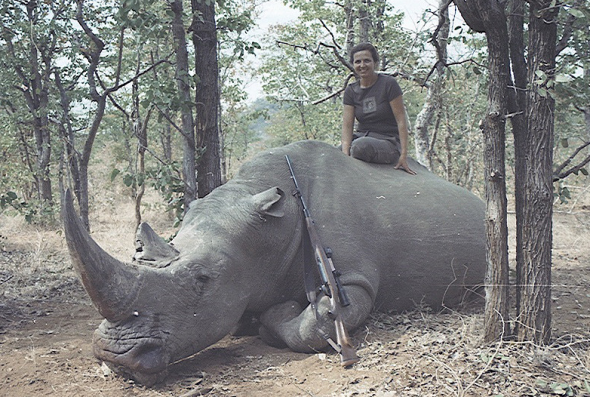
Image: Female rhino hunter, origin of hunter unknown and name. South Africa?
To date there has been very little forthcoming information in relation to revenue generated from African rhino hunts, and where exactly this hunting money is going. Furthermore with rhino poaching still increasing, and tipping points now recorded by ‘various trusted organisations’ the question must now be raised why are we still hunting Rhinoceros?
From the 1940’s tiger hunting was common among many international and local tourists in India. However so too was tiger poaching. It was alleged that revenue from tiger hunting was actually helping to preserve the tiger species and other mammals too. Unfortunately this turned out to be complete codswallop. Then in 1973, the Indian government finally under the orders of Prime Minister Indira Gandhi banned tiger hunting due to so many tigers being poached - and legally hunted at the same time. Had Prime Minister Indira Gandhi not instigated ‘Project Tiger’, the tiger would have gone extinct way back in the 1970’s.
SOURCE: PROJECT TIGER.
In the last 50 years the tiger population in Asia has plummeted from 100,000 to about 5,000. The number of tigers is dangerously low, and the conservation of the world’s remaining tigers is of global concern. Now, in this volume, 40 world authorities on tigers from Asia, Europe, and North America have summarized and identified the management, conservation, and research needs for this endangered species. Before Project Tiger was implemented tiger populations were being hammered. The same identical hunting and poaching behavior before Project Tiger can now be witnessed in Africa - primarily in South Africa where rhinos are also being hammered both by hunters, poachers and pseudo hunters. Does that ring alarm bells among the many FAKE NGO’S out there?
International Animal Rescue Foundation Africa undertook various searches relating to rhino hunting and revenue generated from these hunts within South Africa. What we found was from 2005-2015 a total of 330 ‘White Rhinoceros’ had been legally hunted from 2005-2015. The minimum hunting price was exactly $50,000(USD). While the maximum hunting price was exactly $150,000(USD). It was found that from 2005-2015 and based on the assumption these were (white rhino hunts only) and, taking into consideration the minimum price first. Revenue generated from rhino hunting at the price of $50,000(USD) resulted in an estimated total $181,500,000 million - that’s $181 million(USD) raised from hunting. Meanwhile, and taking into consideration the highest price (being $150,000(USD) a total of $554,500,000 million was generated.
While we cannot place these two equations together and provide a factual sum because we don’t know how many rhinos were legally hunted at each individual price, the sheer fact that millions of dollars has been generated from 2005-2015 should be enough to explain that something isn’t quite right here. Furthermore these figures are based on the assumption these were white rhino hunts,
MINIMUM HUNTING PRICE: 2005-2015 = $181,500,000 million(USD)
MAXIMUM HUNTING PRICE: 2005-2015 = $554,500,000 million(USD)
SOURCE: HUNTING REVENUE.
SOURCE: REPORT TROPHY HUNTING.
To date (and as you can see within the sourced links above) there still hasn’t been a single reliable report that confirms just how much money is being made from trophy hunting in South Africa. The only so called reliable report (which is about as reliable as a chocolate teapot) and, being the only report to surface thus far stated that $200 million(USD) was generated from the years of 2010-2011 (in regards to all South African trophy hunts)? Who number crunched these figures, who even dared to come up with such an absurd low revenue income? I would also like to remind hunting organisations, just because you don’t have to tell us what you’re making, we can contact other organisations/institutions, locate prices, we can phone and email. Eventually we’ll find the truth!
Now either our expert eyes and our mathematical friends are missing something here, or journalists media and the pro trade lobby are forgetting that despite hunting revenue being made pubic. Environmental Scientists can research CITES trophy hunting statistics, then locate the common maximum and minimum price, and the number of rhino trophy heads exported/imported. So as one can read above just from the years of (2005-2015 - millions was made just from Rhinoceros hunting). Moreover who ever came up with the 2010-2011 sum of $200 million USD clearly is missing a lot of money off here, and needs to undertake a mathematical course too?
Rhinoceros hunting is by far the biggest money maker within the hunting business (most of this money is made in South Africa which hosts the largest rhino populations on the planet). Furthermore it just seems too coincidental that from 2010-2011 literally every hunting organisation that’s promoting/advertising rhino hunts has mysteriously removed their prices.
Trophy hunting of rhino is strictly regulated. Every year a total of five (black rhino) can legally be hunted within each of Namibia and South Africa, which totals to a maximum of (ten) per year - five per country. Furthermore in South Africa and Namibia one white rhino can be hunted by one hunter per year - that’s one rhino per hunter every year. Unfortunately there remains no further hunting revenue and data from the years of 2014. Its been estimated by the National Geographic based on the United States Fish and Wildlife report that the United States imported a total of 328 white rhino trophies from South Africa from the years of 2005-2014. Meanwhile a total of 7 white rhino were hunted and subsequently imported to the United States from Namibia from the years of 2005-2014.
SOURCE: NAT GEO HUNTING DATA.
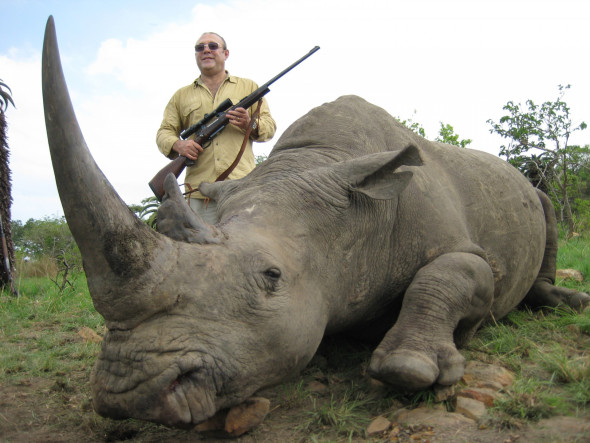
Image Credit: Rhino hunter Alexander Tseytlin
Black rhino hunts have provoked much controversy over the past five years mainly because black rhinos are actually listed as (critically endangered), hence why only five black rhinos can be hunted per year in South Africa and Namibia. Since 1996-2011 the species has been listed as near extinct on the International Union for the Conservation of Natures Red List. Fortunately due to ‘private farming conservation efforts (not wild efforts) the species has allegedly and gradually increased (primarily due to hunting?)’. Both private and wild populations are believed to be increasing within South Africa and Namibia placing the total species population count from 2010 at 4,880 black rhinos.
SOURCE: IUCN BLACK RHINO.
The only reports that we ourselves can offer in regards to black rhino trophy is that of media and press reports that have documented on large scale bidding for black rhino hunts. In January 2014, Corey Knowlton bid $350,000 for a permit to hunt and kill a black rhino in Namibia (Source: Corey Knowlton). Back in June 2016 Namibia offered up three of its black rhinos to trophy hunters. While the price has not been documented its most likely be in the region of just over $1 million(USD) for the three Black Rhinoceros (Source: Namibia black rhino hunt).
Meanwhile back in 1996 a game rancher named John Hume paid about $200,000 for three pairs of endangered black rhinos from the wildlife department of the South African province of KwaZulu-Natal. Among them was a male who would come to be called “Number 65,” and whose death would play a central role in the debate about conservation.
When the black rhino bull arrived, Hume’s farm manager — a burly Zimbabwean named Geoff York whose typical mode of dress is army boots and a pair of purple shorts — tranquilized him, clipped two notches in his left ear and two in the right, and gave him a number: 65. Mr John Hume later picked Mr Peter Thormahlen to organize the killing of ‘number 65’. The price was set at a $25,000 deposit on a $150,000 fee for a seven-day hunt.
Most of that would go to John Hume - the very man that is today advocating for an international legalized trade in rhino horn and has connections to a wide number of organisations such as, WWF, IUCN, CITES, The Department of Environmental Affairs and numerous other figures. Then on July 23rd 2005 Thormahlen and his client with John Hume tagging along proceeded on foot. Suddenly the rhino noticed them and rose from the dirt. The client pulled the trigger, and the first bullet pierced Number 65’s skull. The rhino, still standing, turned. A second bullet hit, and the rhino dropped dead. (Source: John Hume Rhino Hunt).
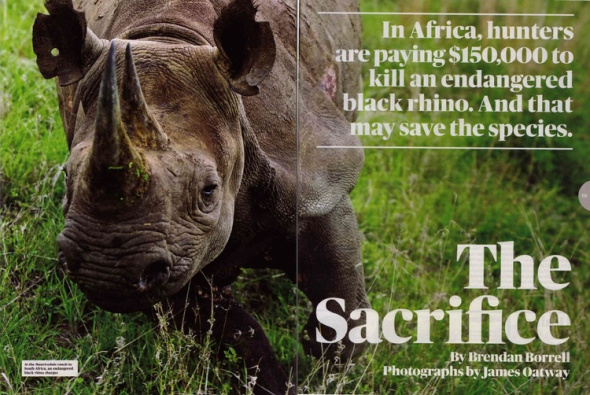
Source: The Sacrifice, please click the source tag for more info
As you can read there is a staggering amount of money parting hands to hunt both black and white rhino. Yet poaching is still skyrocketing? South Africa has lost from 2008 almost 6,000 rhinos to poachers. Back in 2014 Namibia lost a total of 24 rhinos to poaching, then come 2015 a whopping 60 rhinos were poached. (Source: Poaching stats Namibia).
So the question still remains just what exactly is all this money going towards, can each professional hunting organisation prove to me, my organisation and the public that the money generated from rhino hunting is indeed being used to fund anti poaching operations, security, conservation, education, awareness and horn poisoning? (Etc).
While I’ve been extremely silent on this issue too since 2011 I’m going to make it pubic now. I dislike the fact that a ‘prominent South African game hunter’ is involved with the Rhino Orphanage. Back in 2011 we (the organisation) were going to submit funding for scales and equipment, however when running a trace on whom ran the main website, down to a trace on that individuals Facebook page, and more we later discovered a ‘silent partner’ that is hunting many of the big five..
..So who do we trust when it comes to facts and figures? How can we trust anyone that is stating hunting is indeed increasing rhino numbers when literally every individual and organisation are in someway aligned to one another in South Africa and over the borders? Can the Rhino Orphanage and its ‘affiliate’s’ also prove that every single rhino that’s been saved has been released back into a reserve, and not hunted for sport that clearly from this entire document has proved - no amount of hunting whatsoever is increasing rhino populations!
Hunting operations are indeed expensive. While the price of a hunt may indeed seem high. One also has to take into consideration what the farmer and/or professional hunter has to pay for too. Upkeep of land, maintenance of vehicles and buildings, fuel, service charges for gas, electricity, water, and rent Etc, food and beverages for the visiting hunters, guest house uses, damages to guest houses, travel, firearms (among many other bills). Then of course comes anti poaching being the last bill. Some of this expense can be viewed below.
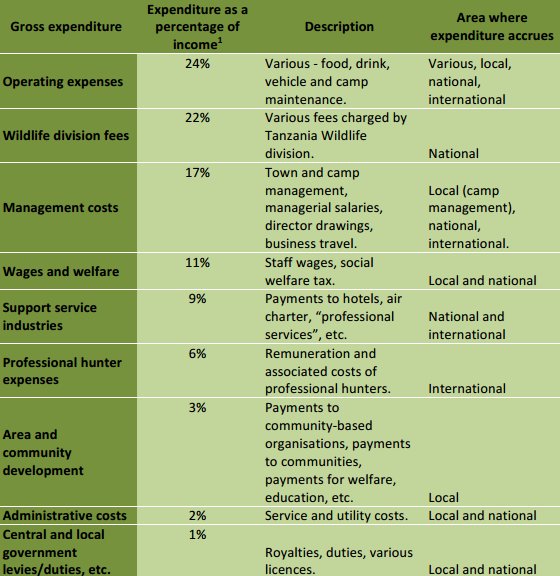
Image: Hunting Charges (Source: IFAW)
While we know that Rhinoceros trophy hunting is indeed expensive, poaching is unfortunately still increasing in various African countries, please do check the sourced links out above, and read that data carefully. The image above with source proves that no big five farmer is taking every single dollar or euro that’s advertises rhino hunting on their site or allows rhino hunting on their property.
So the question remains why are we still hunting rhino for? The question I’ve answered. Rhino hunting is nothing more than a overpaid sport that does nothing whatsoever for conservation and, is not under any circumstances whatsoever contributing to decreasing poaching. All these millions if not billions being made yet here we are still seeing rhinos poached. Finally, and the very best question of them all. If hunting revenue from rhino hunts is not decreasing poaching, how the hell is a so called sustainable rhino horn trade going to decrease poaching? Same money - same prices - going nowhere!
Thank you for reading.
Dr Jose C. Depre PhD. MEnvSc. BSc(Hons) Botany, PhD(NeuroSci) D.V.M.
Master of Environmental, Botanical & Human Science.
Environmental, Botanical and Human Scientist.
FACEBOOK: IVORY TRADE OFF THE SCALE | VIET NAM | PART I
FACEBOOK | IVORY TRADE IN VIET NAM
Written by Dr Jose C. Depre (Chief Environmental Officer).
By the time it takes me to finish this document an estimated 20-50 elephants will have been slaughtered. Once you turn your head and continue to do nothing, come tomorrow 100 elephants would have been killed for their ivory to supply the South East Asian black market. Back in January 2015 I launched yet another online and ground intelligence gathering operation relating to the illegal wildlife trade; We are focusing on China, Viet Nam, Laos, and Thailand of which the team, a twenty four strong experienced male and female unit originate from all backgrounds. Today I’m focusing more on the online trade which has now increased to worrying new levels.
Since January 2015 when [Operation Stop It] was launched Environmental Crimes Officers have found what we believe is a new trend of ivory trade in operation on the United States platform known as Facebook. External Affairs Officers became aware of the huge trade when investigating a Vietnamese national identified as Mr Trang from June 2015 to December 2015. Unfortunately since providing law enforcement agencies with masses of evidence just on this one trader; very little in the way of arrests and/or confiscations has been witnessed.
The ban on international trade in ivory was introduced in 1989 by CITES (Convention on International Trade in Endangered Species of Wild Fauna and Flora) after years of unprecedented poaching. In the 1980’s, an estimated 100,000 elephants were being killed per year and up to 80% of herds were lost in some regions. However despite the ivory trade ban in place, very little in the way of illegal trade reduction is being witnessed within Viet Nam, China, Laos, and Thailand.
Viet Nam is one country of interest that we’ve noted as hosting “unusually large amounts of (raw ivory tusks), most of which seem to be originating from impounded stocks, with other tusks clearly removed from ivory pyres”. While we are aware a large majority of ivory tusks are originating from Africa, there is also a significantly large amount also originating from Asia. Asian ivory tusks are more favored for carving over that of African elephant tusks.
Image: Two tusks located for sale on Facebook 16.05.16 from | impounded or stolen from pyres?
The two elephant ivory tusks (pictured above) were located on Facebook for sale yesterday which we suspect have originated from a recent or past ivory burn. Normally ivory tusks are white, or a dusty creamy color with some dark tinges to them; embers can clearly be seen on the left hand tusk with visible white dehydration and salt marks too.
Image: Ivory jewelry smuggled from Africa into South East Asia now on sale on Facebook.
While the online trade is no big secret, the fact is Facebook hosts no terms and conditions in place that bans such illegal trade; the Facebook platform has no systems in place to recognize such imagery (I.e raw tusks) using BOTS that can then report back to a third party Policing team. Finally IARFA Environmental Crimes Officers have found Facebook is being exploited by many South East Asian citizens primarily from Viet Nam, and Thailand peddling ivory from Asia and Africa.
Image: Ivory trader weighs up tusks he is trading online via pseudo Facebook account shops.
The image above clearly demonstrates just has serious the ivory trade has become online and on the Facebook social media platform. Traders will commonly show their products to prove their wealth (I.e as a status symbol), or to prove/demonstrate the legitimacy of their products compared to other traders, that may be selling counterfeit ivory. The trader who we can only be name as Mr Phong then demonstrates just how much he will be making come the end of the month. The total amount of ivory Mr Phong is selling on Facebook (pictured above and below) will fetch him around $15,000-$20,000USD depending on how the ivory is sold and/or manufactured.
Image: My Phong weighs up this illegal haul of ivory, fetching him some $15,000-$20,000USD
Despite international and domestic trade bans nothing is actually working, furthermore we do hold concerning evidence that shows without a doubt many tusks are being removed from compounds in Asia and Africa then sold onto the very people that police took the ivory from. Police have been witnessed trading confiscated ivory at high prices back into the hands of smugglers knowing too well they are going to make a good wage due to the high demand for ivory tusk products.
Back in 1992 Viet Nam officially outlawed the ivory trade, unfortunately since the ban was implemented any ivory that was purchased before “Viet Nam’s ivory ban” can still be sold legally so as long as the tusks host the correct certification; Fortunately CITES did rule that “re-worked ivory or any tusks/ivory products that were purchased before or after the 1992 Viet Nam ivory ban that are then re-worked, would then be classed as new ivory (non-exempt) thus making that product that was legal - now illegal.
Meanwhile back in 1975 international trade in “Asian elephant ivory” was also banned. There has been quite a few tusks examined by experts and third party experts located on the United States Facebook platform as originating from Asian elephants. Asian elephant tusks are much smaller than your average African bush elephant tusks. Come the 1980’s it was then stated no fewer than 50,000 Asian elephants existed which are now listed on CITES Appendix One and known to [endangered].
One out of every six Hanoi citizens are dealing ivory on the United States Facebook platform. Most of this ivory is as explained originating from Africa and Asia, with clear and obvious signs of trafficking, and thefts from impounded ivory and ivory pyres.
Image: One of many thousands of online ivory trading Facebook shops in Viet Nam.
The image above was picked up from one of many thousands of Viet Nam ivory traders. Traders establish a sophisticated network of “pseudo Facebook accounts”. These accounts are rarely in the real name of the trader. Traces of some accounts via the IARF Environmental Cyber Crimes Unit have shown ivory traders using Virtual Proxy Networks [VPNs] to conceal their Internet Protocol Address.
Furthermore when dealing over the phone traders normally use cheap (non-smart throw away phones) so that should enforcement agencies locate them, tracing the traders exact whereabouts, and who they are selling ivory onto is almost impossible. Its not uncommon to witness traders with a number of cell phones. One phone (the throw away one) will be used for trade and can easily be disposed of with all evidence destroyed containing names and numbers of ivory dealers and buyers. Meanwhile smugglers, traders and carvers also host a smart phone for normal everyday conversations and general surfing the web or interacting with friends and family on Facebook, Twitter or Weibo.
Back in March of 2016 International Animal Rescue Foundation’s- Environmental Crimes Officers located three Viet Nam ivory trading carving factories all advertised on the United States Facebook platform. Moreover it wasn’t just carvers and ivory advertised for sale; we also located evidence of ivory carving tools, measuring and weighing instruments and “DIY ivory carving instructions for beginners”. The carving instruments below were found in one Hanoi carving workshop (on the Facebook social media platform), meanwhile underneath the bottom image is proof of more raw ivory tusk carving.
Image: Ivory carving tools, Viet Nam, Hanoi used to intricately carve ivory.
Image: In the same carving room more raw ivory tusks were located readied for carving on Facebook.
Environmental Crime Officers have located a staggering 80,000 “ivory and wildlife trade shops” all in operation on the United States Facebook platform, yet little if anything is being done to stop this trade or even restrict traders activities. When submitting this evidence with films, images and Facebook accounts and the current laws on ivory trade to Facebook’s Security Head, Alex Stamos we we’re unfortunately ignored.
Yet Facebook’s moderation team are quite willing to remove accounts that have violated their “bullying, harassment or terrorism polices” (all of which are crimes), sadly the social media platform is unwilling to remove highly active wildlife traders breaking domestic and international wildlife laws that are making a ton daily.
On the 3rd March 2016 the BBC reported “Facebook wildlife trade prompts fears among environmentalists”. Traffic - an Environmental Crimes Investigation Organisation located hundreds of online profiles selling endangered and threatened animal species. Facebook stated “It will not hesitate in removing content that is promoting such trade”. Yet when we contacted Facebook submitting more than enough evidence relating to ivory, rhino horn, tiger and pangolin trade all accounts are still in operation.
Facebook did quote though “They are developing practical solutions to combat trade“, unfortunately these solution’s seem to aimed only at “animals rather than animal parts”. For the time being Facebook has no terms or polices in place that would remove illegal wildlife traders dabbling in rhino horn, tiger parts, pangolins, or [non-exempt] ivory. And with some 1.32+ billion Facebook users, Facebook will we believe now have a large job on their hands in combating such trade as from 2014 trade on the Facebook platform has exploded.
“Investigators are concerned that the use of social media and smartphones means that anyone interested in selling wildlife can rapidly access huge numbers of potential buyers”….
Image: More ivory Facebook shops churning out thousands of euro in ivory, all from raw re-worked tusks.
While Facebook has stated they are developing new measures and applications to combat trade, these new measures and whatever applications will be made to combat trade are all too late. Facebook is probably one of very few platforms where you can actually create “private groups”, where only those that are interested in such trade can enter and interact with other users.
Moreover Facebook provides you secrecy in relation to pages; I.e: Traders can censor which countries they don’t want to view their pages then continue trading whatever they like. In relation to pages there are ways and means around that censorship, which will not be published hereto.
One of the largest items we are seeing traded on Facebook is that of ivory bangles, ivory necklaces, ivory wrist bands, ivory chopsticks, ivory pens, ivory encrusted watches, ivory sex toys and ivory cigarette holders (in the thousands). Overseas tourists that visit Viet Nam are often caught or witnessed buying these small cheap products, and the longer they (the tourist) purchase from ivory carvers and traders, the longer demand will continue to increase and fan out. That is one area of the trade we need all be focusing on (demand) to nip in the bud sooner rather than later.
Ground Sales Survey of Ivory:
Back in 2014, a total of 1614 ground outlets were surveyed in 21 localities throughout Viet Nam. Eighty-five of these outlets (5%) were found to have a total of 2300 ivory items for sale. Buon Me Thuat city was found to have the highest percentage of shops (50%) offering ivory. However since CITES has placed more pressure onto Viet Nam to clamp down on ivory and other wildlife trade, these shops are slowly reducing trade, although we do highly suspect traders are now operating more freely on line from which policing this area of the trade is more difficult.
While it was stated that many shops on the ground had increased somewhat, law enforcement in Viet Nam has allegedly made it more difficult for traders to openly trade ivory that has no exemption. Its is for this reason we now believe Facebook is being used more and more to trade ivory products, and as one can see in the images above - we are talking massive amounts of ivory pieces and products, 90% of which hosts no certification, furthermore the vast majority of traders we’ve located are carving products from “smuggled ivory”.
It is presumed that the currency in which the price is listed or quoted in many ivory surveys may indicate the nationality of the most common buyers in that area. Both observations and questions to particular sellers substantiate the fact that ivory is sold to both “foreign tourists and Vietnamese nationals”. For example in HCMC, the majority of the ivory buyers in the two markets are assumed to be tourists from China as prices were quoted in Chinese Yuan.
Video: Bryan Christy examines the illicit ivory trade. Interesting we have also have located a number of “counterfeit tusks that are being traded online and on the ground”. Please stay tuned for article two that will delve a little deeper into both the counterfeit rhino horn, ivory and tiger part trade.
The HCMC silver and gold shops that also offered ivory (particularly the smaller, religious pendants and figurines) appear to be targeting Vietnamese buyers with prices advertised in VND. In Dak Lak and Ha Tien, the majority of the ivory buyers are assumed to be Vietnamese tourists as prices there were quoted in VND. In Ha Noi, prices were mostly given in USD when enquiries were made, which may indicate that the buyers of ivory pieces are likely to be international tourists.
While the majority of ivory is presumed to be aimed at mostly Asian tourists - there is no real hard hitting evidence that this is in deed true. For example if you was British you’re hardly going to purchase an ivory bangle in GBP, so exchanging that currency into Vietnamese dollars then places that ivory for sale (at just about everyone and anyone) with the correct currency.
It may be somewhat of a shock but the UK is the third biggest source of intercepted illegal ivory entering the United States of America (US), which has been singled out by CITES (the Convention on International Trade in Endangered Species of Wild Fauna and Flora) as a ‘problem country’ with a large domestic ivory trade likely to provoke illegal elephant poaching if not regulated and brought under control. London’s Portobello Road – the biggest antiques market in the world – has been identified as the single major source of this illegal ivory.
Furthermore while antique ivory trade is “problematic” so too is non-antique and the longer these trades persist, more and more elephants will be slaughtered for their tusks. We are growing very concerned now at the large number of ivory dealers operating on Facebook. There is clear evidence that much of this ivory is originating from both Africa and Asia, furthermore as explained - the large number of “raw tusks we are locating clearly shows that security is indeed more than questionable at ports, and pounds that hold confiscated ivory.
Image: Raw African ivory tusks, cut and sold onto Viet Nam carvers, on sale on Facebook.
Back in 2015 (just before Christmas) External Affairs Environmental Crimes Officers located an “unusual amount of raw tusks from Africa” that we suspect had made their way into Viet Nam from China. IARFEIA Officers located on the Facebook platform some 21 whole raw and non-certified elephant tusks, some of them even had blood around the bases indicating these were freshly poached ivory tusks; all of which is in violation of both domestic and international ivory trade laws.
Image: Vietnamese ivory carver aged 19 from Hanoi, Viet Nam.
The image above doesn’t really show much does it? although the other images below shows exactly what this talented young man has been creating from raw African and Asian elephant tusks (and is still creating today with his freinds - all college students). Ivory traders and dealers make no attempt at concealing their identity anymore neither. However there still remains a hardcore number of dealers that will continue to conceal their faces, names, and never post images onto Facebook that depicts them holding raw non-exempt ivory. This belief that ivory traders, peddlers, and smugglers were all but old, is now a myth. Today we’re witnessing traders and carvers as young as 16 years old, taking over from their parents thus fueling the ivory trade evermore on Facebook.
Image: Young trader named as Mr Manh exhibits his newly carved ivory pieces on Facebook.
Image:Mr Manh proudly shows one of many hundreds of ivory pens that are in great demand.
Image: Ivory pen with top off, Viet Nam, Hanoi.
Image: Ivory trader identified as Mr Trang proudly displays carved ivory on Facebook for sale.
Image: More freshly carved ivory cartridge pens on sale in Hanoi, via Facebook.
From 2015 (to date) IARFA Environmental Cyber Crimes Officers and the ground team External Affairs Environmental Crimes Officers have found that Viet Nam is “suspected” of peddling more ivory than China and Thailand. Cyber Crimes Officers are now locating every week on average of 2-3 “raw tusk dealers” operating on Facebook. Meanwhile the database of 80,000 ivory and wildlife trade dealers all operating on Facebook continues to increase by the week.
The whole purpose of this article is to wake people up, and open their eyes. We have a major problem on Facebook, and Alex Stamos Facebook Head Security Officer doesn’t seem to be taking much notice of this ongoing and rather concerning problem relating to just the ivory trade alone. We’ve not got much time left, there is an estimated 50,000 Asian elephants in Asia, and “known - some 600,000 African elephants remaining on the continent of Africa with a probable 1.2 million known but (uncounted).
Facebook has become a hotbed for the lucrative and illicit most illegal wildlife trade. And for the time being not a single thing is being done to control this trade. Please sign the petition hereto: http://www.thepetitionsite.com/645/521/701/facebook-remove-illegal-pet-and-wildlife-traders-from-your-server/
“The Extinction Clock is Ticking”
Thank you for reading.
Chief Environmental Officer, Dr Jose C. Depre.
Environmental Crimes Department.
Facebook: Hotbed for Lucrative Ivory and Animal Sales.
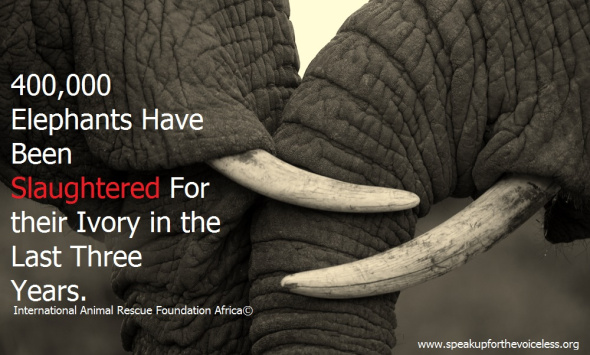
Since 2012 the External Affairs Investigations Unit (EAU), and International Animal Rescue Foundation (IARF), have unearthed a shocking trend of wildlife parts and tropical pet traders on the United States server platform of Facebook.
Operation Trojan Horse has been heading the ground-and-online hunt for traders then shutting them down via intelligence reports passed to the Police, Border Agencies and Internet Service Providers. The Intelligence gathering team state that Facebook is the new wildlife trading site whose technology conceals anything from pornography, murder, child abuse and in this case wildlife parts trade and the tropical pet trade.
Over the past several years we’ve seen a slow decline of wildlife-parts-traders and pet dealers as enforcement tightens around traders and smugglers bringing them to justice. Unfortunately, since as early as 2010 online trade has skyrocketed to new and worrying proportions. Traders intentionally use a textbook of keywords that fool Facebook’s bots and online surveillance teams, according to the External Affairs Unit [comprised of experts from ex-law enforcement officers, intelligence officers and computer experts.]
Investigative officer Tayah, who fronts the main online intelligence gathering team stated: “Firstly I begin by downloading a Virtual Private Network using pseudo details so that my location on G mail or Facebook cannot be traced. Then I have two options after signing up, creating a Facebook group or page. If say I wanted to create a group, I’d title the group using certain keywords to avoid Facebook’s bots and intelligence monitoring teams locating my network. From there I simply add trusted contacts and trade is on in under ten minutes. If I wanted to create a page, I’d again use set keywords and ensure that every country as possible remains banned from viewing the page. I then add say 50+ admins. Job done”.
Tayah makes it sound so easy but exposes a flaw: “Pages that use ‘country banning restrictions’ can still be located in the Facebook search bar. One just changes their Virtual Private Network (GPS) and you can locate anything from illegal porn, animal abuse, wildlife trading, pedophile rings down to dog fighting pages too”. Tayah went onto state: “Unless the user or anyone of the admins unpublished the Facebook page, intelligence gathering is then restricted to Facebook only. If Facebook administrators are unaware of these keywords or technology or are just lacking people power within the law-enforcement department then these ruthless traders will get away with anything”.
Working in conjunction with their Asian counterparts, IARF noticed most traders were deliberately concealing their video and image GPS as well. The problems don’t just end their either. Out of the 1.32 billion Facebook users, a staggering 32 per cent of users log in using a mobile device. One can turn the GPS off on a mobile device and download a Virtual Private Network. For all you know the friend your speaking to on Facebook that’s GPS states there from California in the United States, is really your best friend, wife, husband living with you or near you. That’s how lax Facebook’s online security is.
Tayah goes on to say “The fact I can access pages on Facebook using VPN software clearly shows Facebook is not as secure as it presents itself to be. While Facebook may have protected its millions of citizens, its allowed ruthless and very dangerous criminals to use the platform as a safe haven to buy, sell and trade in illegal animal parts, as well as children, which I’ve witnessed countless times from Russia to Karachi.”
A recent undercover survey uncovered traders selling Slow Loris within Thailand. Slow Loris are protected under Thai law and Cites law (see image below). Please click on all images to be taken to the real time evidence online. We’ve since filed the relevant reports for all and no longer require these images within our file. 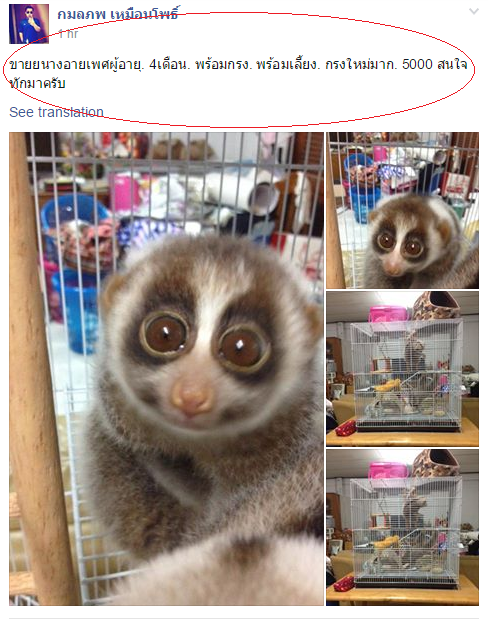
Image: ‘protected’ Slow Loris for sale on Facebook within a tropical pet group.
The trader (pictured above), is not bothered that the Slow Loris is protected under Thailand law. One species out of the five is listed as critically endangered while the remaining four remain listed as vulnerable. The tropical pet trade has been blamed on all five of the species gradually dwindling. Furthermore, Slow Loris despise being handled, brushed or kept as pets.
Slow Loris show a kind of not-bothered-look when being handled by humans. Unfortunately they cannot scream, like we do when tickled, brushed or bathed. Slow Loris hate being handled and do not make good pets. They are solitary creatures and also hate bright light. Yet Facebook has countless numbers of protected Slow Loris for sale, which is absurd, immoral and a slap in the face to conservationists and law enforcement. Is Facebook now above the law?
Facebook must be held accountable for this trade by implementing a ‘strict no wildlife or animal parts trade’ from species that are threatened within their terms and conditions. Should the United States platform not take the relevant actions then we may as well hang up our boots and go home. Frankly we’ve had enough of being ignored and fobbed off.
Endangered Tortoises can be located in many ‘Thai tropical pet and ivory’ trading Facebook forums. The image below depicts a Yellow Foot Tortoise, a species of reptile that isn’t endemic from the region of Thailand. Identified back in 1766 by Professor Carl von Linnaeus, the species is known as Chelonoidis denticulata classified as Vulnerable.
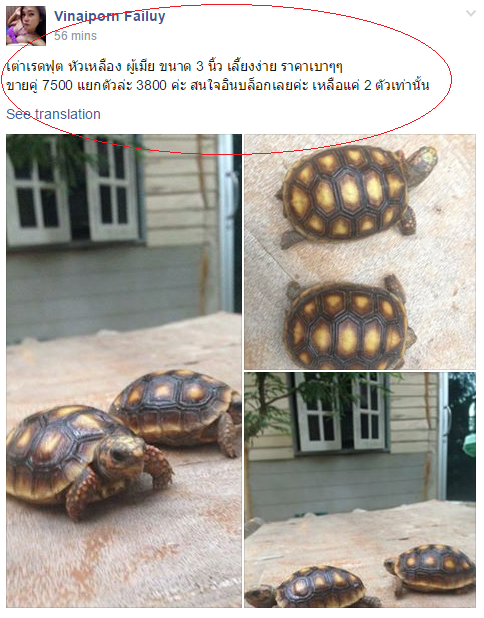
Image: Yellow Foot Tortoise are listed as vulnerable; Pet trade threatens their future.
Although not considered illegal to breed the species, EAU officers from Malaysia were mortified to know the breeder is importing the vulnerable species from South America. The unnamed breeder [not shown above], whom we cannot name, would not divulge how the tortoises are brought into the country but made it clear he could easily obtain more infants on demand, over the border from the wild.
Chelonoidis denticulata is an endangered species. The major populations located in South America are protected under the Convention on International Trade in Endangered Species, Appendix II. As with many species of Turtles and Tortoises, many Brazilian giant Tortoises end up as food items in local markets. This species of Tortoise is popular in the pet trade.
Despite the numerous specimens of endangered and nearing extinct tropical pets for sale on Facebook, one major concern is the illicit ivory trade. Back in 2013 IARF-Asia conducted a random survey within Thailand, aimed at active Facebook members of the public, both female and male from the ages of 16-21. 85% of respondents stated that they would not purchase, deal or trade in ivory and knew where ivory came from. The remaining 15% stated that they had traded, were trading or knew of relatives trading ivory and Rhinoceros horn.
We were skeptical to begin with because according to many third party reports, most whole tusks, or jewelry ivory sales appeared to be traded by adults rather than minors and teenagers. Researching Facebook from 2013 we not only discovered that Facebook was a hotbed for ivory sales - but the teenagers and minors whom IARF-Asia had questioned within Thailand were actively trading ivory online using Facebook. One trader, circled in red within the image below, brags he is trading ‘carved ivory’ within his shop, which later turned out to be his uncles shop (2013.)
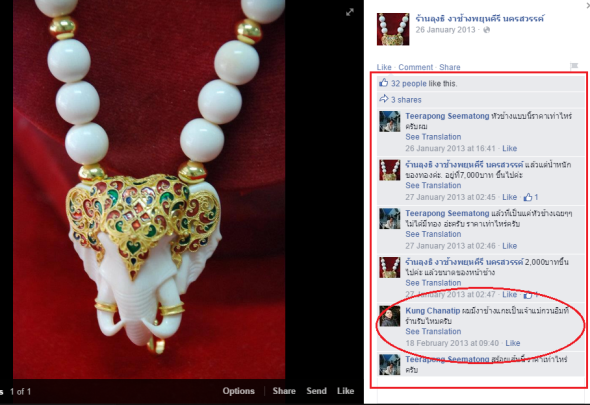
Image: Ivory traders on Facebook 2013
Since re-examining the vast majority of respondents that originally stated they were not dealing with ivory, Facebook seems to have become a hotbed for ivory sales for figurines, pendents, amulets, down to large freshly carved tusks. IARF-Asia also noticed that since Thailand’s new leader, Prayuth Chan-ocha took over the country, ivory trade has increased to shocking levels.
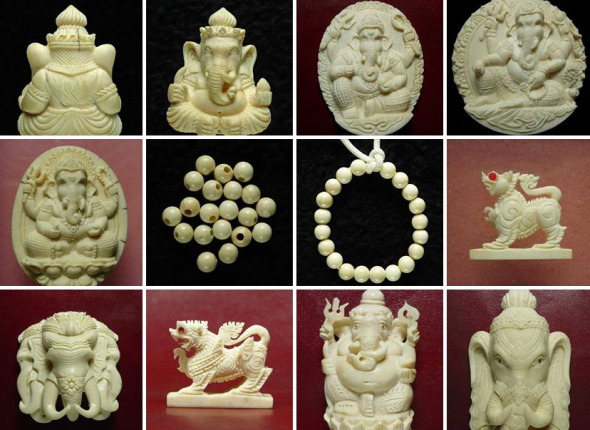
Image: Ivory Facebook profile set up as an online trade shop
Most traders will open up a Facebook account using words such as ‘ivory, ivory carvings, ivory trade, authentic ivory,’ etc. They will post photographs of some of their best selling items and then leave the page, group or their profile open for the public to view. Although the account may appear inactive, the trader silently monitors his account very closely because these profiles are created as mini shops for customers to purchase ivory pendents, charms, bracelets or carved tusks.
We are not only pointing our finger at Thailand or Facebook alone, despite Facebook seemingly unaware these traders are selling freshly carved and re-worked ivory illegally. Click on the image below and you’ll be taken through a Facebook group that is selling anything from Tiger bone wine, Bear claws and of course - ivory, in Viet Nam - on the United States social media platform.
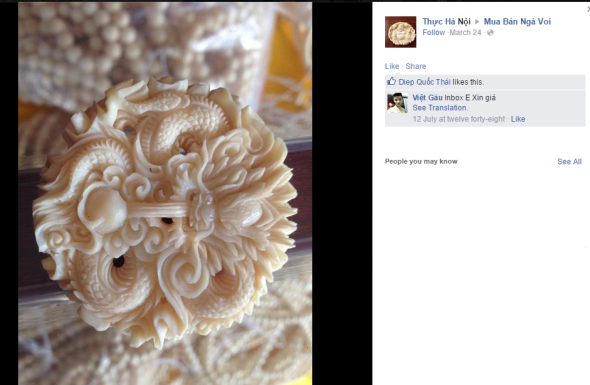
Image: Viet Nam wildlife trading group on Facebook.
Not only insulting Africa’s heritage, but as a smack in the face to conservationists and a punch in the eye to law enforcement, one trader poses with an ivory carved Rhinoceros statue (pictured below.) Facebook is considered to be one of the largest hubs for illegal animal-parts trades that the EAU has located in years. Between 2012 -2105, IARF’s enforcement teams located multiple thousands of illegal traders openly and illegally flaunting Rhino horn and ivory.
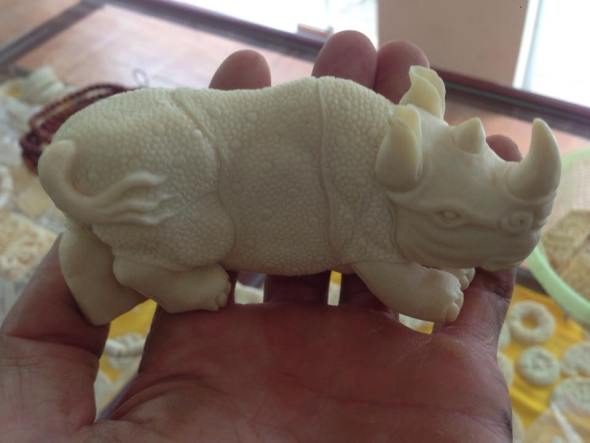
Image: Rhinoceros figurine carved from poached ivory for sale on Facebook.
Shocked and in disbelief at the new findings by IARF’s intelligence teams, we wonder where have we gone wrong. Back in 2013-2014 a massive online enforcement campaign took place bringing down sites trading in animal parts, while Internet Service Providers (ISP) and online buy and sell sites took the pledge to not allow such items on sale. Unfortunately this has pushed many into the secretive and ‘secure’ platform of Facebook.
While there is continued demand and sale for illegal wildlife and animal parts, somewhere on the African or Asian continent an Elephant will be in the cross hairs of a poacher. The illegally poached animal’s body parts will be trafficked from Africa to Asia, then from user to Facebook, to meet the ever increasing demand that is sadly taking the social media platform by storm.
Within the past three years the Convention on International Trade of Endangered Species (CITES), stated some 400,000 Elephants had been slaughtered on the African continent alone.
There have been numerous large seizures of ivory and convictions of persons involved. Some countries are burning stockpiles of ivory to send a clear message to poachers and traders but despite these actions, the ivory trade continues. China announced in June of last year that enforcement teams had seized a total of 270 kilograms of ivory and Rhinoceros horn. Yet despite such seizures the trade goes on in the face of the law and as Facebook seems non-to-bothered some of the 1.32 billion users are using the platform as a trade and sell site laughing in the face of enforcement and conservationists.
In another shocking Facebook find, a routine search of Japanese traders revealed peddlers openly selling African Elephant ivory online. The shop (listed below), is set up as a hobby shop which works old and new ivory, creating pendents and necklaces, etc. The Japanese shop’s ivory belongs to Elephants which were illegally slaughtered on the continent of Africa, along with some re-carved antique specimens, which therefore continues demand and the illegal poaching. Please click on the image below, which will direct you to the Japanese Facebook page.
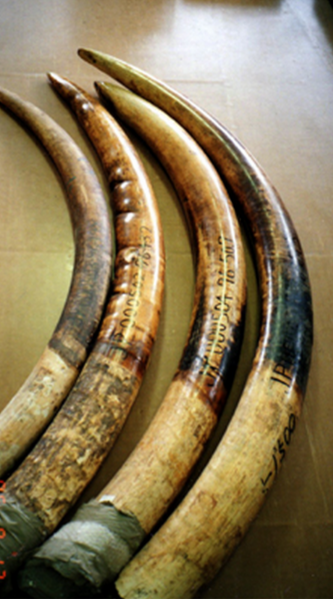 Image: African Elephant Ivory.
Image: African Elephant Ivory.
In April this year, Excellency Shinzo Abi was encouraged by major animal welfare organizations to cease trade in ivory and destroy any stockpiles being held in Japan. Since 1970, Japan has imported ivory from more than 250,000 African elephants, mainly from tusks that were illegally acquired through poaching wild elephants.
Japan has been granted permission twice to buy ivory, despite the UN Convention on International Trade in Endangered Species of Wild Fauna and Flora (CITES) 1989 ban on international commercial trade in African elephant ivory, which was adopted in response to the global elephant poaching crisis of the 1970s-80s.
In 1997, Japan secured CITES-approved ivory sales for nearly 50 tonnes of ivory from Zimbabwe, Botswana, and Namibia. In 2008, Japan was allowed to import a further 48 tonnes of ivory. Japan agreed to implement a domestic ivory control system that would prevent the laundering of illicit ivory, as a condition of both sales. This system has not worked, instead it has increased international demand for ivory and driven up poaching rates.
Of particular concern is the ivory “registration” program which can be used to grant legal status to illegal tusks or tusks of dubious legality. In the last four years alone, the Government of Japan has “registered” 5,600 tusks weighing more than 50 tonnes, bringing the total registered since 1995 to over 14,000 tusks, comprising 185 tonnes of ivory.
The “registration” of ivory tusks is a massive loophole that can be used to launder illegal ivory onto the Japanese market.
Read more here
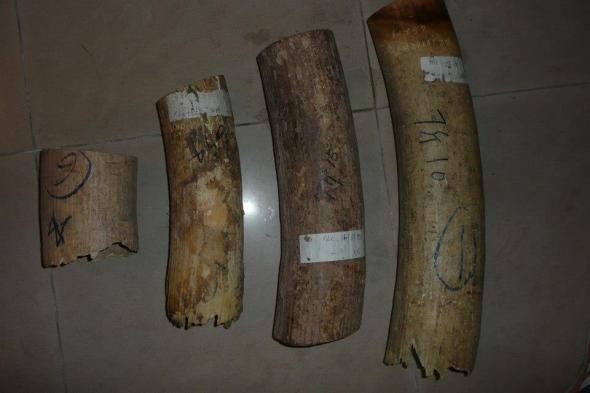
Image: Japanese Ivory trader selling freely on Facebook.
The image below was posted among other groups from a man known as Mr Houng (power), who appears to communicate with a woman known as Miss Grace Chung, who we believe is from Osarka, Japan and runs various ivory carving shops (please click the image below to view groups). While the EAU team cannot provide any real data on these two individuals, they appear to be financially well off and have no problems at locating ivory. Miss Chung has three to four Facebook groups and various pages linked to Chinese ivory trading shops. Miss Chung is directly related to the Japanese ivory dealer and ‘alleged’ hobbyist above.
Mr Houng is seen communicating to Miss Chung within her alleged ‘ivory stone and wood workshop.’ The woman states “that’s a lot,” while other Facebook users display their ivory through images, throughout this group and a further group (which we have accessed but cannot disclose at this time.) All the ivory within the image below derives from 99% non-permitted ivory, meaning its illegal and has no permits whatsoever as investigated by the EIA.
The left hand image’s GPS is from China. We’ve checked various sources in relation to the right hand image and sadly there is not a trace that we can find. Based on Mr Houng’s monetary status, it is quite possible he knows exactly whom this ivory belongs too as he posted the photograph, which seems untraceable on all five of the top search engines. It would be wrong to accuse Miss Chung of any wrongdoing in relation to either image, however the image above derives from a Japanese Facebook ivory workshop which posts images of significantly high volumes of cut off ivory pieces.
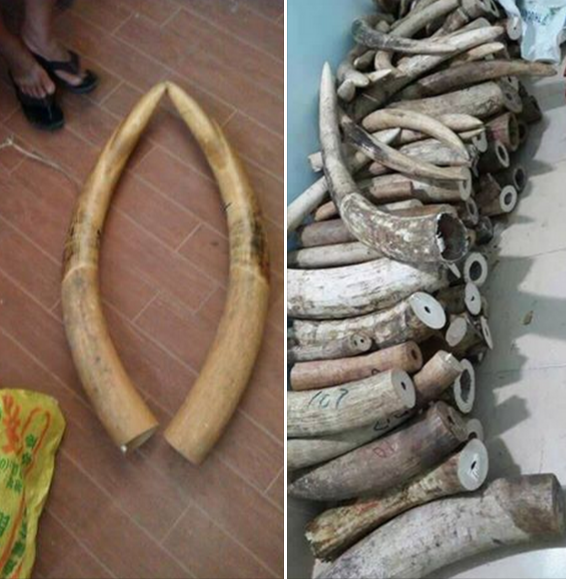
Image: close to two tons of African Elephant ivory.
Some Facebook groups and pages also contain walrus ivory which isn’t illegal if the animal died naturally or you legally hunted the animal. The problem surrounding walrus ivory is that some traders of elephant ivory use walrus ivory as a smokescreen to sell elephant ivory online. Unless you are an ivory expert, it is difficult to distinguish the difference between elephant ivory and walrus ivory. Elephant ivory traders do their best to conceal their trade by either stating their part of a walrus ivory group and/or trade Elephant ivory into, or against walrus ivory, furthermore some online ivory dealers trade under the name of ‘ox-bone’. Only ivory experts can tell the difference. Can you tell the difference from the images above to the images below without Googling?
Image: walrus tusks
Even some of the best experts can at times fall prey to the walrus ivory trade - however there is a difference. Walrus tusk ivory comes from two modified upper canines and is known as a material, as morse. The tusks of a Pacific walrus may attain a length of one meter. Walrus teeth are also commercially carved and traded. The average walrus tooth has a rounded, irregular peg shape and is approximately 5 cm in length. Lets see whom can tell the difference or if there is a difference.
Poaching of protected or managed species, trafficking and the illegal trade in wildlife and their related parts and products has escalated into an international crisis in the last decade! Wildlife trafficking is both a critical conservation concern and a threat to global security, with significant effects on the national interest of the United States and the interests of our partners around the world. For every piece of ivory that is purchased the money from that ivory then makes its way back to terrorists.
Using money from illegal trade in wildlife and related parts and products, terrorists such as Al Shabab then commit atrocities such as filmed within the video below. These atrocities are funded exclusively by each person who purchases ivory. The more ivory bought and sold, the more it empowers terrorist activity.
The video included below provides a non-graphic but powerful account of how ivory sales and trade funds terrorism. Please do view the video and take into account all those innocent civilians that could be with us today. Sadly they’re not all due to ivory funded terrorism.
The current number of remaining African Elephants is not known, due to their large migratory behavior. We do know that in Central Africa all Elephant ‘populations’ are endangered. In Eastern Africa Elephant populations are listed as vulnerable. South African Elephant populations are listed as least-concern and finally, in Western Africa Elephant populations are listed as vulnerable. Please refer to the table contents below, lifted from the last revised summery.
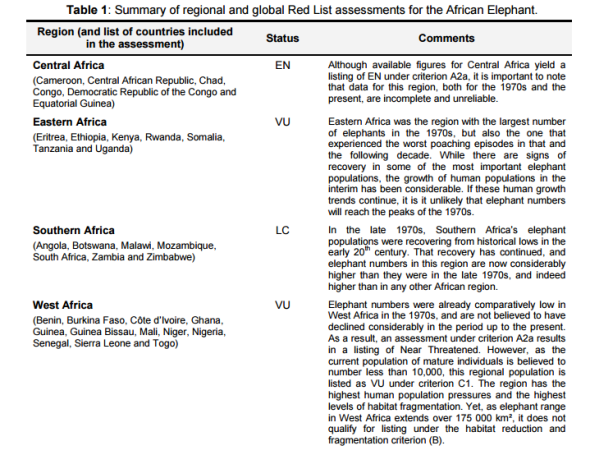 Image: table of assessments for the African Elephant
Image: table of assessments for the African Elephant
Whilst overlooking Viet Nam, CITES issued Thailand a direct warning in May, to quit the illegal ivory trade or CITES would impose immediate trade sanctions against the country. Why not Viet Nam, Japan or China?
Thailand ‘had’ until the end of March 2015 to take measures to shut down domestic trade in illegal elephant ivory or it will face trade sanctions under the Convention on the International Trade of Endangered Species (CITES), which met in Geneva last July. It must enact legislation to stem the trade of illegal African ivory in the country and implement a registration system for domestic ivory and ivory traders.
“WWF welcomes this decision and applauds the key role of the US delegation in holding Thailand accountable for their lack of progress since 2013 when it pledged to shut down its ivory market,” said Leigh Henry, WWF’s Senior Policy Advisor at the meeting. “Elephants across Africa and Asia are being slaughtered for ivory and illegal markets in countries like Thailand are allowing wildlife crime to flourish.”
Possible sanctions would impact Thailand’s trade in species covered by the convention, including ornamental plants, such as orchids, and reptile leather. Trade suspensions would, for example, prevent exports of orchids, which would result in a loss of more than $80.7 million in annual sales based on the 2013 value of this trade. The economic impact would be significant as the value of just some of Thailand’s CITES-listed export items was estimated at $157 million in 2012.
So we’ll now await for Cites response and if any trade sanctions will be imposed, IARF will also be calling on the same trade sanctions to be imposed on China, Japan and Viet Nam. After all the evidence is above for all and sundry to view - and this is just a mere 1% of evidence we hold on file of past and present illegal ivory trade.
Meanwhile a staggering ‘estimated’ one hundred Elephants are being slaughtered daily on the continent of Africa with some ten to fifteen killed a week in Asia. We plead with all our supporters 5.4 million of you, to demand Facebook now cleanses their server of all illegal ivory traders, shops, groups and individual buyers. We must continue to disrupt the trade, failing this we’ll never tackle the demand problem, and sadly Elephants will soon become nothing but a story or artifact within a dusty museum.
Thank you for reading.
I thank all members of the External Affairs Unit, International Animal Rescue Foundation Asia and the current operation leaders that have been fronting the online task force since 2010 known as #OperationTrojanHorse..
Dr Jose C. Depre
Chief Environmental Officer
Chief Executive Officer

